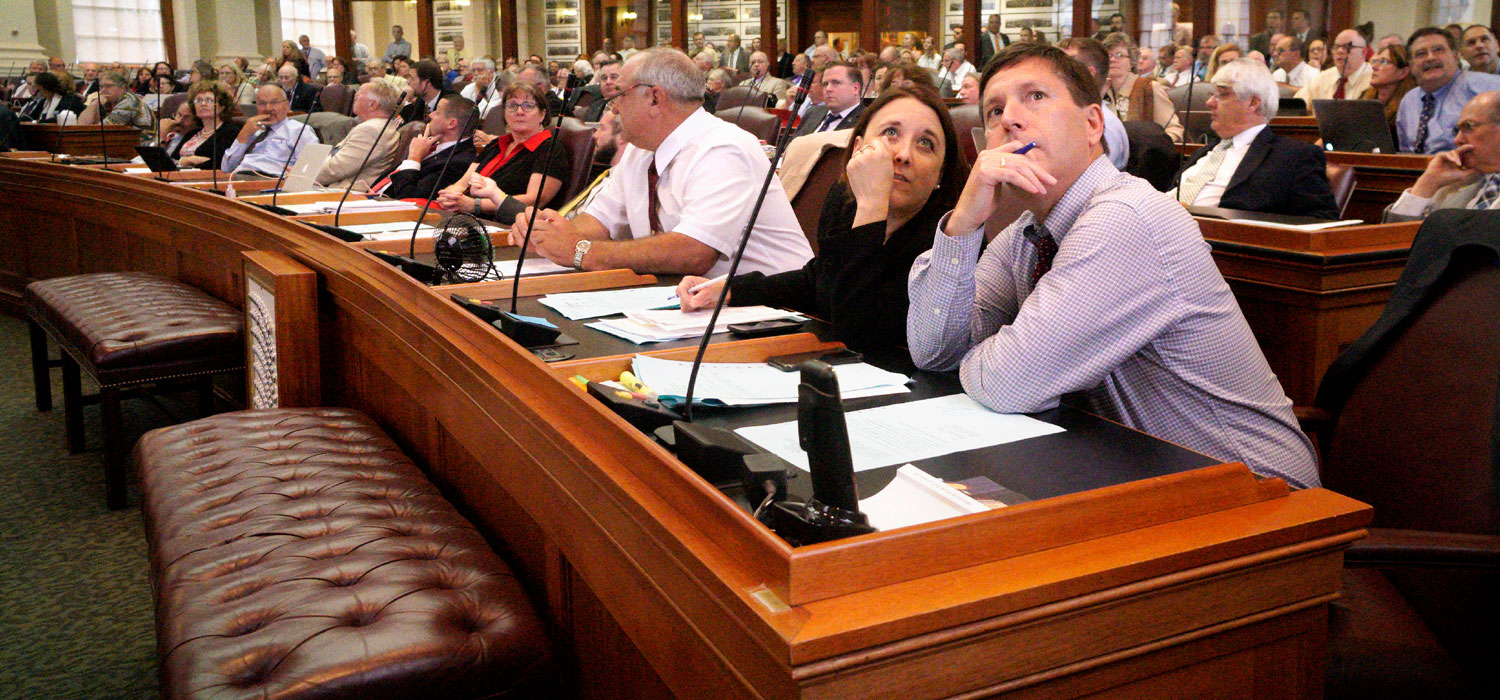
<p>House Minority Leader Kenneth Fredette of Newport, right, and House Assistant Minority Leader Ellie Espling of New Gloucester watch the votes come in on a vote board during a vote on the state budget in the Maine House chamber on Friday, June 30, 2017. Photo by Gregory Rec/Portland Press Herald via Getty Images.</p>
Balanced budgets are a popular political talking point among state governors.
On the campaign trail, they often brag about single-handedly balancing their states’ budgets. And at home, they praise their states' fiscal discipline while criticizing federal spending habits.
But this display of fiscal restraint is not entirely voluntary, nor is it always beneficial.
Forty-six states and the District of Columbia have balanced budget requirements (BBRs). In principle, these fiscal measures prohibit states from spending more than they collect in revenue, but the reality is often more complicated.
These requirements make a splash each year as states go through their budget cycles. Pennsylvania balanced its revenues and spending after a four-month budget impasse this year. The state even earned a credit downgrade. And Maine went into government shutdown for four days before finally adopting a balanced budget in July.
Balanced budget requirements have become a pillar of state budgeting practice. But do they work? And how do we determine whether they’re effective? Here’s what the evidence says.
Stricter balanced budget requirements produce “tighter” fiscal outcomes, but they can cause more fiscal and economic volatility
Strict BBRs are constitutional and prohibit states from carrying a deficit into the next fiscal year. They require the legislature to pass and the governor to sign a balanced budget, rather than merely propose one.
Research shows that strict BBRs reduce spending, lower deficits, and hasten responses to revenue shocks. Other studies have found less debt, lower borrowing costs, and higher surpluses.
Although proponents of fiscal restraint applaud tighter fiscal outcomes, there are trade-offs.
Research suggests that strict BBRs can increase state economic and fiscal volatility, making large swings in state revenue or the economy even larger. This can compromise financial planning and continuity of services.
Balanced budget requirements can also force states to raise taxes or slash spending in an already retracting economy. During deep or lengthy economic downturns, states are more likely to cut spending than increase taxes. Strict BBRs can force swift and deep cuts to services like school aid and optional Medicaid programs.
The requirements can cause states to impose harsh cuts when a state is already hurting, which can prolong a downturn or delay a recovery.
States should learn from past mistakes and refine budget practices to ensure fiscal health
States must balance their budgets during good times and bad. But do states always make a good-faith effort to do so?
Balanced budget requirements typically only apply to operating budgets. Some states have delayed pension fund payments to cover other expenses. New Jersey cut such a deal in 2014, as did Connecticut in 2010.
Other states have pushed a payroll or state aid payment from the last month of the current fiscal year into the first month of the next year, allowing them to legally meet the BBR while leaving the true balance of resources and obligations in the red. Hawaii performed such a move in 1998, as did California in 2009.
Some of this slack can give states flexibility to respond to unexpected revenue declines. One-time accounting fixes may be more desirable than cutting critical services during a recession.
But these moves can become a problem when states use them during good times and bad. Actions that might help states respond to an unexpected drop in revenues can jeopardize states’ fiscal health if they are used regularly. And, as evidenced most recently in Pennsylvania and Illinois, research suggests bond markets tend to penalize states when they fail to meet BBRs.
So, what should states do?
Research shows that strict BBRs are most effective when paired with a generous rainy day fund. States can reap the benefits of a strict BBR by placing higher surpluses into a savings account. One 2006 study found that the larger a state’s rainy day fund, the smaller its budget gap during recession years because states use stabilization funds to plug budget holes during recessions.
States should assess the costs—and benefits—of a strict balanced budget rule, and policymakers should consider how to combine and refine budget practices to ensure long-term fiscal health.
Phoebe Keller contributed to this post.
Let’s build a future where everyone, everywhere has the opportunity and power to thrive
Urban is more determined than ever to partner with changemakers to unlock opportunities that give people across the country a fair shot at reaching their fullest potential. Invest in Urban to power this type of work.